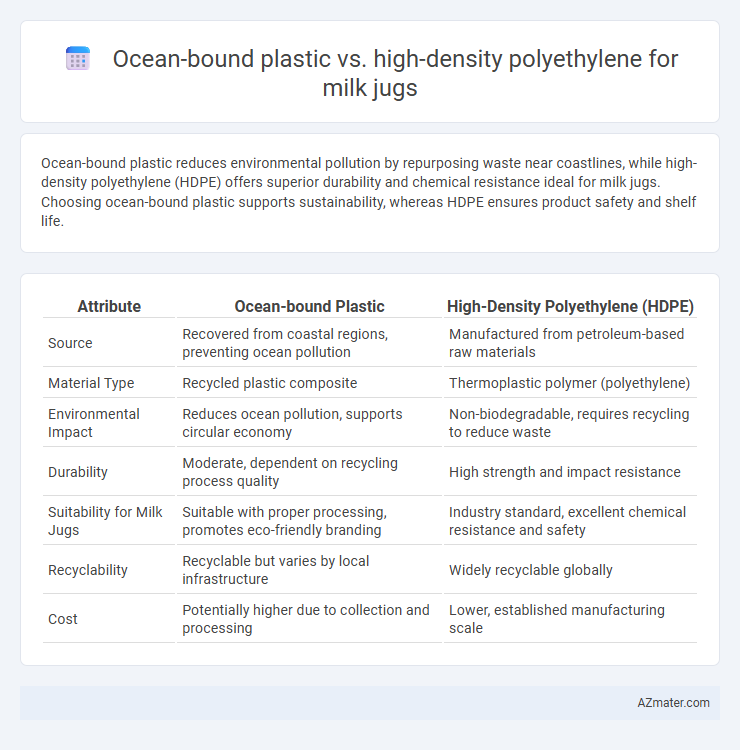Ocean-bound plastic reduces environmental pollution by repurposing waste near coastlines, while high-density polyethylene (HDPE) offers superior durability and chemical resistance ideal for milk jugs. Choosing ocean-bound plastic supports sustainability, whereas HDPE ensures product safety and shelf life.
Table of Comparison
| Attribute | Ocean-bound Plastic | High-Density Polyethylene (HDPE) |
|---|---|---|
| Source | Recovered from coastal regions, preventing ocean pollution | Manufactured from petroleum-based raw materials |
| Material Type | Recycled plastic composite | Thermoplastic polymer (polyethylene) |
| Environmental Impact | Reduces ocean pollution, supports circular economy | Non-biodegradable, requires recycling to reduce waste |
| Durability | Moderate, dependent on recycling process quality | High strength and impact resistance |
| Suitability for Milk Jugs | Suitable with proper processing, promotes eco-friendly branding | Industry standard, excellent chemical resistance and safety |
| Recyclability | Recyclable but varies by local infrastructure | Widely recyclable globally |
| Cost | Potentially higher due to collection and processing | Lower, established manufacturing scale |
Understanding Ocean-Bound Plastic
Ocean-bound plastic refers to waste materials collected near coastal areas before they enter the ocean, preventing marine pollution and promoting environmental sustainability. High-density polyethylene (HDPE) is a durable, recyclable plastic commonly used for milk jugs, offering excellent barrier properties and chemical resistance. Utilizing ocean-bound plastic for milk jug production combines HDPE's functional benefits with environmental impact reduction by repurposing coastal waste.
What Is High-Density Polyethylene (HDPE)?
High-Density Polyethylene (HDPE) is a durable thermoplastic polymer widely used in manufacturing milk jugs due to its strong chemical resistance and high tensile strength. HDPE's dense molecular structure makes it ideal for preventing contamination and preserving milk quality, distinguishing it from ocean-bound plastic, which consists of recycled waste collected near coastal areas. Using HDPE in milk jugs supports food safety standards while ocean-bound plastic offers an eco-friendly alternative by reducing marine pollution through recycling efforts.
Sustainability: Ocean-Bound Plastic vs HDPE
Ocean-bound plastic offers a sustainable solution by repurposing waste collected near coastlines, significantly reducing ocean pollution and supporting circular economy initiatives. High-density polyethylene (HDPE) is widely recyclable and durable but relies on virgin fossil fuel resources, contributing to environmental impact through extraction and production. Choosing ocean-bound plastic for milk jugs enhances sustainability by decreasing marine debris and promoting the use of recycled materials, while HDPE's recyclability ensures continued material reuse in packaging industries.
Material Properties and Performance
Ocean-bound plastic, typically composed of recycled polyethylene terephthalate (PET), offers sustainable properties but may present variability in purity and structural integrity compared to virgin materials. High-density polyethylene (HDPE) used for milk jugs provides consistent chemical resistance, impact strength, and moisture barrier properties essential for dairy product preservation. While ocean-bound plastics contribute to environmental benefits, HDPE maintains superior performance characteristics critical for maintaining milk quality and shelf life.
Environmental Impact: A Comparative Analysis
Ocean-bound plastic significantly reduces environmental pollution by diverting waste from marine ecosystems, lowering oceanic plastic debris and its harmful effects on marine life. High-density polyethylene (HDPE) milk jugs, while recyclable, often contribute to landfill accumulation and require substantial fossil fuel resources for production. Comparing both, ocean-bound plastic offers a more sustainable alternative by promoting circular economy practices and decreasing plastic leakage into oceans.
Safety and Food-Grade Compliance
Ocean-bound plastic and high-density polyethylene (HDPE) differ significantly in safety and food-grade compliance for milk jugs. HDPE is widely recognized for its FDA approval, non-toxicity, and resistance to chemical leaching, making it a trusted material for direct food contact and milk storage. Ocean-bound plastic requires rigorous processing and certification to meet food-grade standards, which can be challenging due to potential contamination and the need for thorough purification to ensure safety and regulatory compliance.
Recycling and End-of-Life Considerations
Ocean-bound plastic, sourced from waste near coastal areas, contributes to reducing marine pollution and supports circular economy goals when recycled into milk jugs. High-density polyethylene (HDPE), widely used for milk containers, offers excellent recyclability with established collection and processing infrastructure, facilitating efficient end-of-life material recovery. The comparison highlights ocean-bound plastic's environmental benefit in waste diversion, while HDPE provides superior mechanical properties and recycling efficiency, making both materials critical for sustainable milk jug production.
Cost Comparison: Ocean-Bound Plastic vs HDPE
Ocean-bound plastic offers a cost-effective alternative to traditional high-density polyethylene (HDPE) for milk jugs by reducing raw material expenses through recycling initiatives, often lowering production costs by 10-20%. HDPE remains widely used due to its consistent quality and lower processing costs, but fluctuating oil prices can increase its price volatility. Choosing ocean-bound plastic not only supports environmental sustainability but also provides a competitive edge in pricing within dairy packaging markets focused on eco-conscious consumers.
Consumer Perception and Market Trends
Ocean-bound plastic appeals to eco-conscious consumers who prioritize sustainability and environmental impact, driving a growing market trend toward recycled and repurposed materials. High-density polyethylene (HDPE) remains favored for its durability, lightweight properties, and superior moisture resistance, maintaining strong consumer trust for milk jug packaging. Market data indicates rising demand for ocean-bound plastic as brands emphasize circular economy practices, yet HDPE continues to dominate due to established supply chains and regulatory compliance.
Future Prospects in Milk Jug Packaging
Ocean-bound plastic offers a sustainable alternative for milk jug packaging by significantly reducing plastic waste that threatens marine ecosystems while aligning with growing consumer demand for eco-friendly products. High-density polyethylene (HDPE) remains the industry standard due to its durability, recyclability, and safety for dairy products, but innovation in incorporating ocean-bound plastic into HDPE blends is advancing. Future prospects involve scaling the integration of ocean-bound plastic in HDPE milk jugs, enhancing circular economy initiatives, and meeting stricter environmental regulations to achieve lower carbon footprints in dairy packaging.

Infographic: Ocean-bound plastic vs High-density polyethylene for Milk jug
 azmater.com
azmater.com